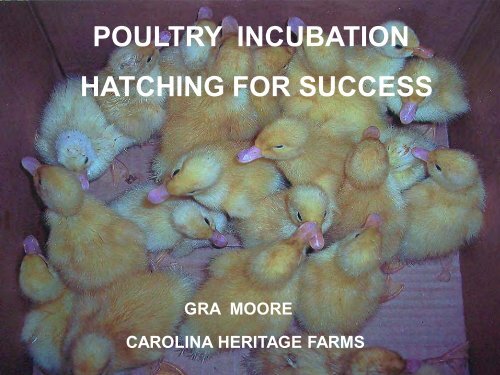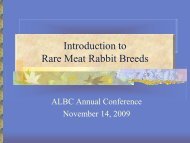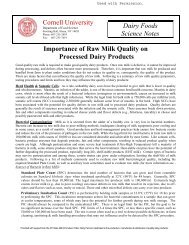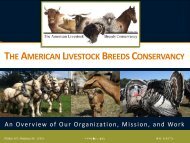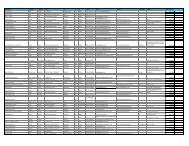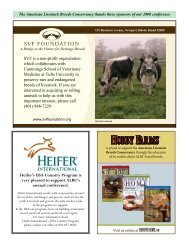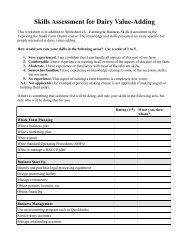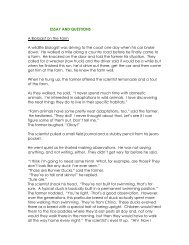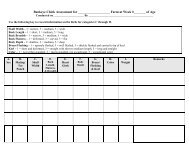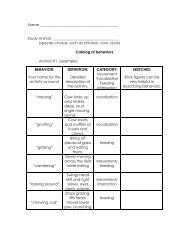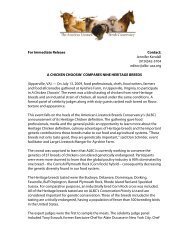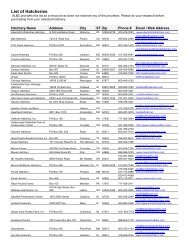POULTRY INCUBATION HATCHING FOR SUCCESS
POULTRY INCUBATION HATCHING FOR SUCCESS
POULTRY INCUBATION HATCHING FOR SUCCESS
Create successful ePaper yourself
Turn your PDF publications into a flip-book with our unique Google optimized e-Paper software.
<strong>POULTRY</strong> <strong>INCUBATION</strong><br />
<strong>HATCHING</strong> <strong>FOR</strong> <strong>SUCCESS</strong><br />
GRA MOORE<br />
CAROLINA HERITAGE FARMS
FOUR BASIC REQUIREMENTS<br />
AN EGG NEEDS TO HATCH<br />
Temperature 99 - 102 Deg. F.<br />
Humidity 50%-65% RH<br />
Egg Turning at least 2x/day<br />
Air Flow air and gas exchange
TWO TYPES OF <strong>INCUBATION</strong><br />
ARTIFICIAL<br />
INCUBATOR<br />
NATURAL<br />
BROODY HEN
NATURAL<br />
1. The Broody hen is a time tested way to hatch eggs.<br />
2. Very good at her job.<br />
3. To use a hen for hatching you have to do one of two<br />
things<br />
a. Find a hen sitting.<br />
b. Induce a hen to sit.
SIGNS OF BROODINESS<br />
1. Clucking<br />
2. Stays away from the rest of the flock<br />
3. Ruffled feathers<br />
4. Aggressive and protective of nest<br />
5. On the nest at night
CARE OF THE BROODY<br />
HEN<br />
1. Hens like dark dry<br />
places to sit.<br />
2. Needs to keep away<br />
from other hens<br />
(other hens will<br />
break her eggs).<br />
3. Needs good supply<br />
of water and food.<br />
4. Needs an area to stretch<br />
her legs and relieve<br />
herself.<br />
5. Make sure hen is free<br />
from internal and<br />
external parasite.
BREEDS THAT MAKE GOOD BROODY HENS<br />
•Silkies<br />
•Cochins<br />
•Game Hens<br />
•Wyandotte<br />
•Orpingtons<br />
Barred Rock<br />
•Silver Leghorns Buckeyes<br />
•(Non-Industrial)<br />
•Most Heritage Breeds<br />
(They retain the broody<br />
characteristics)<br />
Heritage<br />
Turkeys
PROS<br />
1. No electricity<br />
2. Hen does all the work<br />
3. Will brood chicks after they hatch.<br />
4. High hatchability rate<br />
5. Some breeds hatch better under hens<br />
(Nankin) than in incubators.<br />
6. Good for hatching small # of chicks per<br />
year.
CONS<br />
1. Hen sometimes breaks eggs.<br />
2. Will occasionally quit and get off nest.<br />
3. Hen sitting is 1 less not laying in the<br />
flock.<br />
4. Can only sit on a small # of eggs at a<br />
time.<br />
5. Disease transmission from hen to<br />
chick
ARTIFICIAL <strong>INCUBATION</strong><br />
Still Air Incubation:<br />
1. No fan<br />
2. Has a heating element<br />
3. Uses a wafer thermostat<br />
4. Humidity or water pans at bottom<br />
5. Relative humidity of 50% -60%<br />
6. Temperature 101-102 degree
7. Most made of Styrofoam or plastic<br />
(home made can be made of other<br />
material)<br />
8. Screen for eggs to lie on<br />
9. Egg turning kits are available for some<br />
models<br />
10. Will hold a limited number of eggs<br />
11. Operate in a room temperature of 50-<br />
80 degrees (out of sunlight)<br />
12. Incubate and hatch on same wire floor
1. GQF<br />
2. Little Giant<br />
3. Brinsea<br />
4. Home Made<br />
TYPES OF STILL AIR<br />
INCUBATORS
PROS<br />
1. Easy to use<br />
2. Not very expensive<br />
3. Does not take up much room<br />
4. Good for hatching small to medium #<br />
of chicks<br />
5. Does not use much electricity
CONS<br />
1. Hatchability can be low<br />
2. Temperature and humidity can be hard<br />
to regulate<br />
3. Some models you have to turn eggs by<br />
hand<br />
4. Hot and cold spots in incubator<br />
5. Can have high number of deformities<br />
in chicks<br />
6. Can be hard to clean
Forced Air Incubation<br />
1. Fan<br />
2. Coil heating element<br />
3. Wafer or electric thermostat<br />
4. Humidity pan<br />
5. Relative humidity of 50% -60%<br />
6. Ideal Temperature is 99.5 degrees F
7. Some models have hatching tray at<br />
bottom<br />
8. Openings in back of incubator<br />
for humidity<br />
9. Automatic egg turner (turns every 2<br />
hours)<br />
10. Large egg capacity<br />
11. Operate in a room temperature of 50-<br />
80 degrees<br />
12. Draft free room with fresh air
<strong>FOR</strong>CED AIR TYPES<br />
1. GQF<br />
2. Dickies<br />
3. Roll X-Incubators<br />
4. Nature Form<br />
5. Brinsea Bators<br />
6. Hovabator & Little Giant<br />
still air with forced air fan kit<br />
7. Home Made<br />
8. Robbins – no longer made<br />
9. Petersime – no longer<br />
made<br />
10. Jamesway – no longer<br />
made<br />
11. Buckeye – no longer made<br />
Homemade type<br />
Nature form “Safari”
PROS<br />
1. Hatchability usually very good<br />
2. Most Forced Air Styles will last for years<br />
3. Incubators can easily hatch several<br />
thousand chicks per year<br />
4. Fairly easy to clean<br />
5. Almost a turn key system<br />
CONS<br />
1. Can take up a lot of room<br />
2. Can be expensive to buy
<strong>FOR</strong>CED AIR HATCHERS<br />
1. Same as incubator but has hatching trays instead of<br />
turners<br />
2. Hatcher temperature should be set at 98.5 deg. F and<br />
humidity 65% or higher.<br />
3. High heat and high humidity is a lethal combination
EGG COLLECTION<br />
1. Collect eggs every day<br />
2. Should use a good nesting material<br />
a) hay<br />
b) wheat straw<br />
c) pine shavings<br />
3. Only set good quality eggs<br />
a) no cracked eggs<br />
b) really small eggs<br />
c) really big eggs (double yolked)<br />
d) abnormally shaped eggs<br />
e) extremely dirty eggs<br />
f) thin shelled eggs
SANITATION OF EGGS<br />
1.Warm water and bleach<br />
2.Warm water and dish soap<br />
3.Tek-Trol disinfectant<br />
4.Extremely dirty eggs do not set<br />
5.Pooled eggs<br />
6.Custom hatching
EGG STORAGE<br />
1. Ideal storage for eggs should be around 55 deg.-<br />
60 deg. F. at 70% -75% humidity<br />
2. Cell division starts at 72 degrees F<br />
3. Good places to store eggs:<br />
a) egg cooler<br />
b) closet in house<br />
c) shop or barn<br />
d) anywhere it is close to desired temperature<br />
and humidity<br />
e) does not have to be exact to be successful<br />
4. Turn eggs at least 2 x a day to prevent yolk sticking.<br />
5. Eggs should not be stored much longer than 10<br />
days.
SETTING EGGS<br />
1. Regulate incubator<br />
temperature and humidity<br />
and let run for 2-3 days.<br />
2. Set eggs in trays little end<br />
down big end up (air<br />
cell).<br />
3. After eggs are set, expect<br />
incubator temperature to<br />
drop, temperature will<br />
regulate.<br />
4. Predation in incubator
CANDLING EGGS<br />
(Candler, Flash light or Light Box)<br />
1. Candle eggs after 7-10 days to<br />
check for clears and blood rings.<br />
2. High number of clears could mean<br />
infertile roosters.<br />
3. High numbers of blood rings could<br />
mean unhealthy or old breeding<br />
stock.<br />
4. Good way to check on the<br />
progress of the embryo<br />
5. Make more room in incubator or<br />
hatcher<br />
6. Keep bacteria down<br />
7. Good way to check humidity level
<strong>HATCHING</strong> PROCESS<br />
1. Three days before eggs are scheduled to<br />
hatch; eggs should be placed on their<br />
side in the hatching tray.<br />
2. Raise humidity to 60% or higher.<br />
3. Lower temperature to 98.5 deg. F. @ 1<br />
degree.<br />
4. After chicks hatch leave in hatching tray<br />
for 24 hours to harden off.
5. Return temperature and humidity back<br />
to where it was.<br />
6. Trouble shooting<br />
7. Culling weak chicks (Methods)<br />
8. Toe punching to identify matings<br />
9. Keep good records to track your success
INCUBATOR SANITATION<br />
1. Should clean incubator racks and trays every 2-3<br />
hatches.<br />
2. Chick fuzz and fecal matter will accumulate quickly.<br />
3. Vacuum chick fuzz and dirt.<br />
4. Use Tek-Trol or Bleach for cleaning.<br />
5. Easy to let slide, but very important.
PROBLEMS ASSOCIATED WITH DIRTY INCUBATOR<br />
1. Mold build-up<br />
2. Bacteria contamination<br />
3. Low hatchability<br />
4. Deformities in chicks<br />
5. Eggs exploding due to bacteria build- up<br />
6. Disease problems
BIO-SECURITY<br />
1. Wear certain clothes and boots only while tending<br />
your poultry or hatching area.<br />
2. Clean boots and disinfect at the beginning and<br />
end of each visit to your poultry or hatching area.<br />
3. Store feed out of reach of rodents and wild birds.<br />
4. Regularly clean and disinfect buildings, pens,<br />
equipment, incubators and hatching area.<br />
5. Use common sense if you tend a poultry sale or<br />
auction.<br />
6. Have a quarantine area set up for new birds<br />
approximately for 30 days.
7. If you are pooling eggs with other breeders be<br />
sure breeders birds are clean.<br />
8. Limit traffic on your farm.<br />
9. Not wise to let people borrow your incubator.<br />
10. Develop a bio-security plan for your farm and<br />
hatching area.<br />
11. Visit the ALBC website section on bio-security.<br />
12. Vaccinate your breeding flock.<br />
13. Participate in the NPIP.
MARKETING YOUR <strong>POULTRY</strong><br />
Big demand for heritage poultry<br />
1. Exhibition poultry<br />
2. Backyard flocks<br />
3. Pasture poultry<br />
producers<br />
and niche<br />
marketing.
GETTING YOUR NAME OUT<br />
1. Put ad in state agriculture<br />
paper.<br />
2. Join breed clubs and breed<br />
list-servers<br />
3. Join ALBC and have your<br />
farm listed in the Breeders<br />
directory.<br />
4. ALBC Classifieds<br />
5. Develop a web site<br />
6. Get to know the local farmers<br />
in your area<br />
7. Develop relationship w/local<br />
feed stores.<br />
8. Local processors<br />
9. Animal Welfare Institute<br />
(encourage locally sourced chicks)


